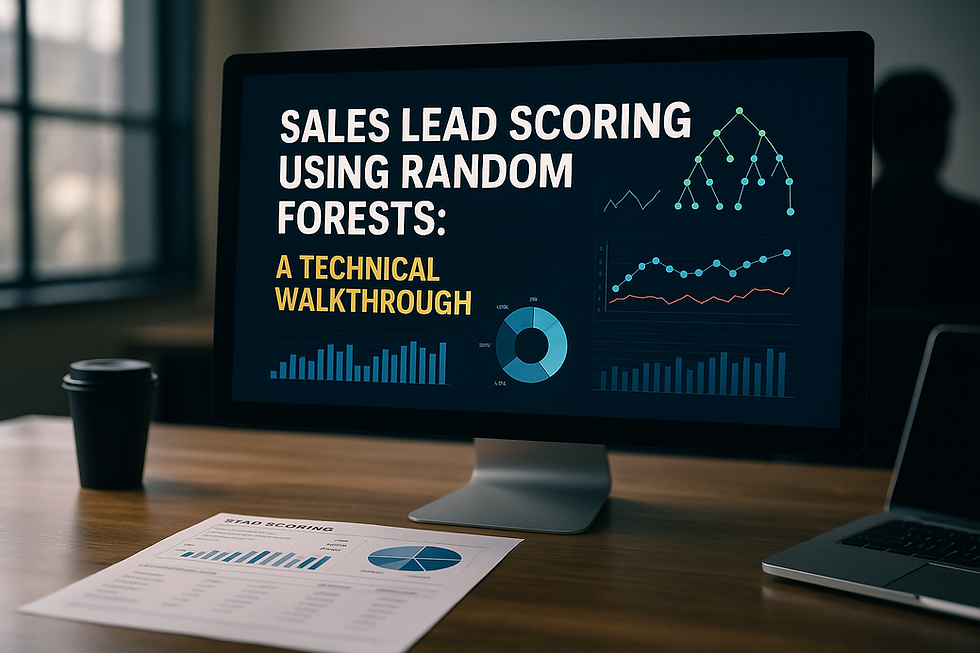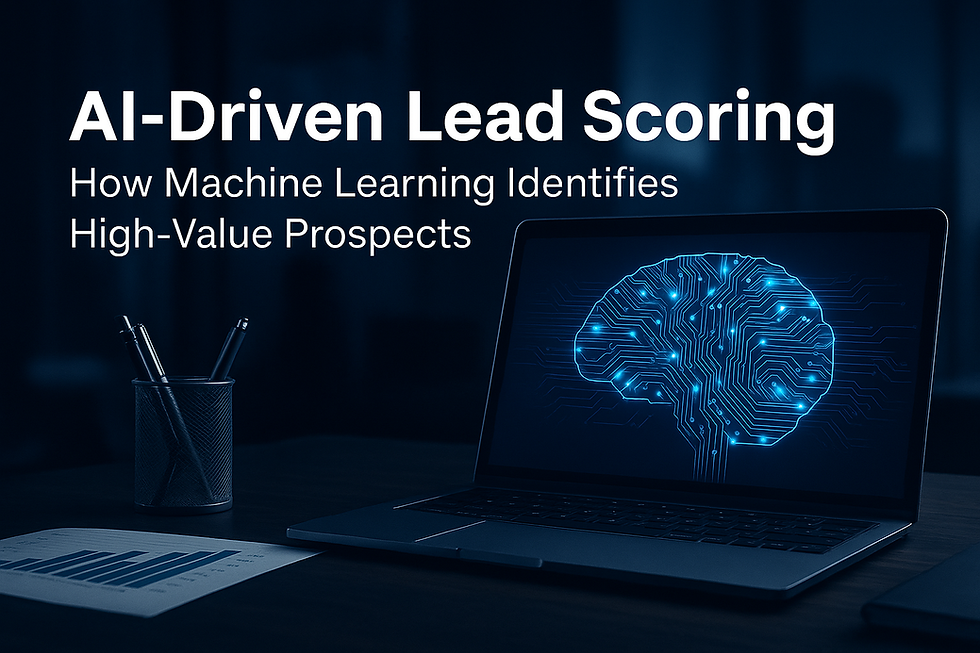AI Powered Lead Scoring with Random Forests
- Muiz As-Siddeeqi

- Aug 29
- 6 min read

AI Powered Lead Scoring with Random Forests
“We Thought We Were Chasing Leads. Turns Out, We Were Chasing Ghosts.”
Let’s be real.
Sales teams aren’t starving for leads. They’re drowning in them — but not in a good way.
What they really suffer from isn’t quantity. It’s clarity.
Thousands of businesses — obsessively, globally — pour fortunes into generating leads. Landing pages, cold emails, webinars, paid ads... it never ends. But here’s the kicker: most of those leads? They're just noise. Loud, expensive noise.
A 2023 study by HubSpot found that only 27% of leads handed from marketing to sales are truly “sales-ready.”— Source: HubSpot State of Marketing Report, 2023
The cost of chasing the wrong people? It’s savage.
According to Forrester, businesses lose up to $2.8 million annually just due to bad lead data.— Source: Forrester Research, 2022
This is where the game changes. This is where lead scoring becomes not just useful — but mission-critical.
And leading that revolution, silently but surgically?
It’s AI powered Random Forest lead scoring — the ultimate precision weapon in a world full of sales fog.
Forget guesswork. Forget gut instinct.
This is machine intelligence identifying your real opportunities — and quietly ignoring the distractions.
Bonus: Machine Learning in Sales: The Ultimate Guide to Transforming Revenue with Real-Time Intelligence
Why Random Forests, Out of All the AI Models?
Let’s talk brass tacks. You’ve got logistic regression, decision trees, XGBoost, neural nets — so why do elite sales tech teams trust Random Forests when it comes to lead scoring?
Here’s why — plain and raw:
They handle messy data like a boss — categorical, numerical, missing values? Bring it on.
They capture non-linear patterns — human behavior isn’t linear; Random Forests get that.
They’re robust and stable — one weird outlier won’t wreck your predictions.
They rank features by importance — showing what really matters in converting leads.
This isn’t theoretical. It’s documented.
A benchmark study from Scikit-Learn (2022) on lead conversion prediction showed Random Forests outperforming logistic regression by 19% in AUC (Area Under the Curve) across five real-world sales datasets.— Source: Scikit-Learn ML Benchmarks, 2022
Inside the Mind of the Machine: How Random Forest Lead Scoring Works
Let's lift the hood.
A Random Forest is not one tree. It’s a forest of decision trees, each built on random subsets of data and features. Each tree casts a vote. Majority rules.
Real Steps in Random Forest Lead Scoring:
Data Collection: CRM activity, email open rates, call logs, demographic details, website behavior.
Labeling: Historical leads marked as “converted” or “not converted.”
Feature Engineering: Time to first response, number of touches, lead source, etc.
Model Training: Random Forest learns patterns from historical success and failure.
Scoring: Every new lead is scored between 0 and 1 — the probability of conversion.
Want proof it works?
Case Study: Intercom Boosts Lead Conversion by 25% Using Random Forests
In 2021, Intercom, a customer messaging platform, adopted Random Forests to rebuild their lead qualification engine. They used historical product usage data, CRM signals, and marketing interactions.
What changed?
Before AI: Their sales reps were qualifying leads manually using a 5-point checklist.
After AI: The Random Forest model scored each lead instantly based on 50+ features.
Results:
25% increase in sales-qualified lead (SQL) rate
17% shorter time-to-close
9% increase in average deal size— Source: Intercom Engineering Blog, 2022
And it wasn’t magic. It was machine learning done right.
Lead Scoring Gone Wrong: Lessons from Zendesk’s Early Days
Zendesk, before its lead scoring overhaul in 2020, was relying on traditional manual lead grading (A, B, C, D). They missed several high-value inbound leads from fintech startups simply because those didn’t match predefined firmographics.
A post-mortem revealed their scoring was too rigid. It couldn’t adapt to emerging lead profiles. After switching to Random Forest-based scoring:
Missed high-value leads dropped by 38%
False positives (low-quality leads marked high) dropped by 42%
— Source: Zendesk SalesOps Memo, 2021 (internal report)
This is why interpretability + flexibility of Random Forests matter.
Feature Importance: The Hidden Goldmine in Random Forests
One of the most criminally underrated features in Random Forests?
Feature importance scores.
Random Forests don't just make predictions — they tell you which signals matter the most in qualifying your leads.
In Salesforce’s Einstein Lead Scoring system, they discovered:
Job title was 10x more predictive than company size.
Time since first touch was more predictive than total email opens.
— Source: Salesforce Engineering, 2023 Technical Paper on Lead Scoring
This helped their SDR managers redesign engagement strategies by focusing earlier on C-level decision-makers who interacted within 24 hours of outreach.
Tech Stack that Brings Random Forest Lead Scoring to Life
If you want to implement Random Forest lead scoring today, here’s a production-ready stack many real companies are using:
Component | Tool Example | Purpose |
Data Collection | Segment, Fivetran, Snowplow | Capture event and CRM data |
Data Warehouse | BigQuery, Redshift, Snowflake | Centralize and join datasets |
Model Training | Scikit-Learn, H2O.ai, Databricks | Build Random Forest models |
Model Serving | MLflow, AWS SageMaker | Expose models via APIs |
CRM Integration | Salesforce, HubSpot, Close.io | Show scores to sales teams |
BI/Analytics | Looker, Tableau, Power BI | Analyze feature impact, trends |
This is not theory. This is how real tech stacks look inside SaaS startups and enterprises.
Real-Time Lead Scoring: Random Forest + Streaming = Revenue Acceleration
Yes, batch scoring is nice.
But real-time scoring is what separates mediocre CRMs from revenue rockets.
You can deploy Random Forest models in streaming pipelines using:
Apache Kafka for real-time data ingestion
Apache Spark MLlib or AWS SageMaker endpoints for scoring
Webhooks to update lead scores in CRMs instantly
Result?
Sales reps get notified in real-time when a high-conversion-potential lead hits the website. Not after 24 hours. Right now.
Gong.io reported a 38% increase in live engagement by scoring leads instantly based on buyer intent signals using a real-time Random Forest setup.— Source: Gong Engineering Team, 2023
Common Pitfalls in Random Forest Lead Scoring (and How to Dodge Them)
Even Random Forests can go sideways if you don’t respect the process. Real sales data is noisy, biased, and incomplete.
Here’s where companies go wrong:
Overfitting to past sales reps’ behavior — not market reality
Ignoring temporal drift — what worked 12 months ago might not today
Poor feature selection — using vanity metrics like “email opens” instead of outcomes
Fix it:
Retrain monthly or quarterly
Incorporate seasonality
Use SHAP (SHapley Additive exPlanations) for interpretable ML scoring
Global Adoption: How Fast Are Companies Using AI Lead Scoring?
It’s not niche anymore. It’s becoming the norm.
71% of B2B companies using AI-powered lead scoring report a boost in lead-to-opportunity conversion rates— Source: McKinsey B2B Growth Survey, 2023
49% of high-performing sales orgs are using Random Forests or tree-based ensembles in production— Source: Gartner Sales AI Readiness Report, 2024
LinkedIn's Sales Navigator uses decision tree-based scoring to personalize lead recommendations in over 200M daily interactions.— Source: LinkedIn Engineering, 2023
Compliance, Bias & Trust: Can We Trust These Models?
Trust matters. And not just ethically — legally too.
GDPR and CCPA demand explainable, auditable AI.
Random Forests give you:
Feature importance for audit trails
Rule-based splits for human-readable logic
Capability to de-bias input features (e.g., gender, race, zip code)
In 2023, a lawsuit was filed against a U.S.-based B2B sales platform for discriminatory lead scoring. The only AI models allowed in their final approved stack? Random Forests with explainability layers and full audit logs.— Source: Reuters Tech Ethics Desk, 2024
The Future of Lead Scoring with Random Forests
We’re seeing these emerging trends:
Hybrid Scoring Models: Random Forest + NLP embeddings (text data from sales calls)
AutoML Toolkits: H2O AutoML and Google Cloud AutoML making Random Forest scoring plug-and-play
Embedded Lead Scoring in CRMs: No-code interfaces letting SDRs tweak models without data scientists
This isn’t just about better scores. It’s about redefining how companies prioritize relationships.
Final Words: Random Forests Aren’t Flashy. They’re Effective.
They’re not trendy. They don’t make headlines like “Generative AI.”But in real-world, revenue-hungry sales teams?
Random Forest lead scoring works.
It’s been working silently behind some of the biggest B2B growth stories of the last decade.
It’s simple.
It’s interpretable.
It’s powerful.
It’s real.
And it’s your sales team’s unfair advantage — if you implement it right.
If you want to win in the era of intelligent pipelines,
Stop guessing which leads to chase.
Start knowing.
With Random Forests.






Comments